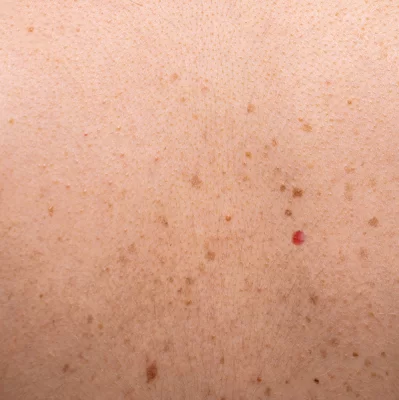Ruby points
- What are ruby points?
- What are the causes of ruby spots formation?
- Can ruby points indicate diseases?
- When should ruby points be consulted with a doctor?
- What are the methods of removing ruby points?
- What are the contraindications for ruby point removal procedure?
- How to prevent the formation of new ruby points?
Ruby spots, also known as cherry angiomas, ruby spots or De Morgan's spots, are common and completely benign skin changes. They originate from blood vessel cells. These small marks appear as small bumps with an intensely red, sometimes even purple, color, typically ranging from 1 to several millimeters in diameter. Their characteristic ruby hue is due to the presence of hemoglobin in the dilated vessels. Cherry angiomas are merely a cosmetic concern and pose no health risk. They are most commonly found on the trunk, arms, and thighs, where they can be mistaken for moles.
Ruby points are small skin changes that occur due to excessive growth of blood vessels, when endothelial cells multiply intensively, creating new capillaries. Genetic predispositions play a significant role in their formation. Their number often increases with age, especially after the age of 30.
Hormonal fluctuations, such as those related to estrogen levels during pregnancy or after menopause, also contribute to their appearance. Other factors influencing their development include: excessive sun exposure, chronic stress, unhealthy diet, and exposure to certain chemicals. It is worth noting that women with fair skin seem to be more susceptible to these changes.
Ruby spots, although usually benign, can be a warning signal when they appear suddenly and in large numbers. Their presence often indicates liver problems such as cirrhosis, fatty liver, or inflammation. Sometimes they are even called "liver tears."
In rarer cases, the sudden appearance of these skin changes may be associated with more serious conditions such as neuroendocrine tumors or POEMS syndrome. They may also accompany metabolic disorders, such as diabetes or hyperlipidemia, and thyroid diseases. Furthermore, their presence can be a sign of problems with the circulatory system.
Ruby moles are usually harmless. However, in certain situations, a visit to a dermatologist is necessary. Pay attention to the following symptoms:
- rapid development of the mole,
- change in shape or color,
- bleeding, either spontaneous or after irritation,
- burning,
- itching,
- redness or swelling,
- inflammatory state.
The specialist will conduct a diagnosis, often using a dermatoscope to differentiate between a hemangioma and a dangerous melanoma. If in doubt, a biopsy may be ordered. Regular check-ups are necessary if you have many such moles or if their appearance raises concerns.
Aesthetic medicine offers a range of effective and usually non-invasive methods for eliminating ruby points.
The most commonly chosen method is laser therapy, which utilizes precise laser energy to target blood vessels. This process, known as photothermolysis, causes the vessels to shrink or close, leaving the skin around them intact. Laser therapies such as Dye VL, Excel V+, as well as PDL and IPL technologies are used for laser therapy.
In addition to laser therapy, there are also other effective techniques for eliminating ruby points. Electrocoagulation involves using current to cut the protein in the vessel, while cryosurgery freezes the lesions using liquid nitrogen. Surgical removal of lesions is very rarely used, mainly for diagnostic purposes. It is also worth mentioning newer, increasingly popular methods of eliminating ruby points, such as microplasma beam.
Removing ruby points, although effective, has certain limitations. The procedure is not recommended for pregnant or breastfeeding women. It cannot be performed if there are:
- active skin infections (bacterial, viral, fungal),
- skin cancer diseases,
- predisposition to scar formation,
- fresh sunburn (in the case of laser therapy),
A contraindication to the procedure is also taking medications or herbs with photosensitizing effects. Always inform your doctor about all medications and supplements taken before removing any lesions.
Although ruby nevi, especially with genetic predispositions, cannot be completely avoided, the risk of their occurrence can be effectively minimized. The key is sun protection throughout the year using sunscreen with UV filters (SPF 30-50). Equally important is a healthy lifestyle. Remember to:
- have a balanced diet rich in vitamins C and K, which strengthen blood vessels,
- stay properly hydrated,
- take care of your skin,
- avoid irritating substances,
- choose hypoallergenic cosmetics.
However, if ruby nevi turn out to be a symptom of a more serious condition, comprehensive treatment focusing on the underlying disease is necessary.

